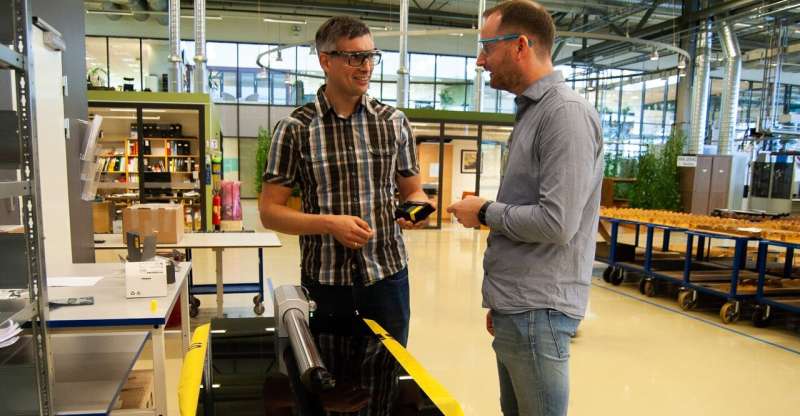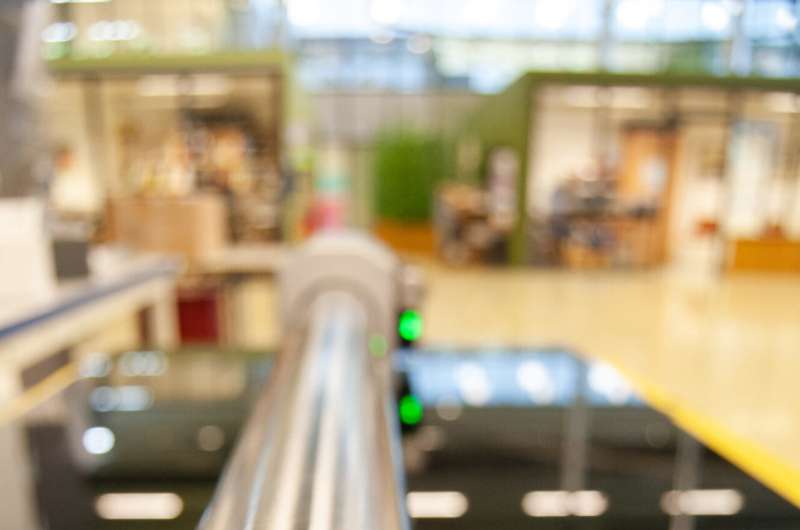Project manager Tormod Jensen (left) and SINTEF researcher Terje Mugaas discussing the potential of new a tool equipped with sensors. Credit: Håvard Egge.
A small machining company in Norway is the first in the world to use digitalized tools for advanced turning. The technology enables the prevention of damage to complex and expensive parts used in the aircraft and gas industries.
Digital tools are making their entrance into the machining sector—and it's all happening in Trondheim, Norway. With help in sensor development from researchers at SINTEF Digital and the company Tecnec Larsen, machining company Sandvik Coromant has developed tools installed with sensors that provide operators with full control of the turning process. This will save companies both time and money, ensure high and consistent levels of quality, and prevent too many parts from being discarded as scrap.
Sensors installed in the tools ensure that companies manufacturing components for sectors such as the aircraft and gas industries obtain important data during the process, and that the results are documented. This means that it is possible to optimize production and prevent unwanted incidents.
"To date, the project has been a great success and very well received," says SINTEF researcher Terje Mugaas. "It's clear that major savings will be made by adopting a technology that prevents damage from occurring during these processes—a phenomenon that is currently not unusual when producing very complex and expensive parts," he says.
Impossible to see the end result
The company Sandvik Teeness in Ranheim, a subsidiary of Sandvik Coromant, has been responsible for development of the technology. It has specialized in turning, milling and drilling tools for use with metals, with a focus on long and slender tools that have a tendency to start vibrating during such processes. This makes it difficult to machine the smooth surfaces that are essential if strict production requirements are to be met.
The key challenge is that the operation commonly occurs deep in the interior of large components, which makes it impossible to see the end result before the process is completed—when there is no turning back. It doesn't take much before a component has to be scrapped.
"In the past, the operator had to rely on his or her experience, and to listen to the process in order to discover defects. However, now that machines are becoming increasingly enclosed, this approach has become somewhat difficult," says Mugaas.
Sensors provide information about the entire process
So now, a number of sensors installed in the tool will ensure that information about the entire process is communicated to users, informing them of what is going on even in the deepest holes.
"We've installed sensors as far forward, and as close to the cutting edge, as possible so that we can obtain an optimal dataset," says Tormod Jensen, who is Project Manager at Sandvik Coromant. "We're able to do this because we make both the tools and the sensors ourselves," he says.
The sensors are connected to a sender located at the rear of the tool, which transfers all the data wirelessly to a PC or tablet.
World-leading innovation
In 2018, the technology was recognized as the most innovative product at the IMTS expo in Chicago—one of the biggest machining expos in the world, boasting 2,563 exhibitors and 129,000 visitors.
"We have good reason to be proud of our product—winning first prize among so many exhibitors, all competing to display the latest thing," says Mugaas.
The technology has been developed as part of a BIA (user-driven) research project funded by the Research Council of Norway. Jensen says that Sandvik Coromant's success has relied entirely on research funding.
This long and slender tool is installed with sensors at the front end, close to the cutting edge. The sensors are connected to a sender that transfers the data wirelessly to a PC or tablet. Credit: Håvard Egge
"When our researchers started work on the project there was no-one at Sandvik Teeness working with electronics or programming," says Mugaas. "Today, the former nail and rivet factory in Ranheim on the outskirts of Trondheim is at the leading edge of the so-called Industry 4.0 revolution in the machining sector," he says.
"At SINTEF Digital, our aim is to contribute to the digitalization of Norwegian industry, and this is a good example of a project that offers us an opportunity to digitalize a traditionally mechanical process," says Mugaas. "This is the first machining company in the world to install sensor technology in its tools," he says.
The technology enhances the process involved in the machining of deep holes in the following ways:
- the sensors provide information about the shearing process by monitoring vibration levels and any bending experienced by these long and slender tools
- the sensors are sufficiently accurate to measure the very fine cuts made during the final phase of machining
- the result is more data, process optimisation, reductions in production time and documentation of the outcome.
Data displayed on a PC or tablet
Data from the sensors are displayed on an easy-to-read interface on a PC or tablet.
"The interface displays data sent directly from the tool to the user," says Jensen. "The algorithms display vibration levels so that the user can be notified when these become too high. We can go in here to reset threshold levels and make adjustments. In this way we become familiar with the process," he says.
Moreover, there is a column that transmits a warning when it detects unwanted vibrations, and another that indicates how much power is being used. This provides information about the load stresses on the tool.
"There are also warning signals, correction recommendations and auto-mechanisms that stop the machine if this becomes necessary," says Mugaas.
Advanced components
Sandvik Coromant's tool is being used to make components for applications such as subsea installations, aircraft landing gear and car engines. It goes without saying that such industries operate with strict requirements regarding interior surfaces. However, by using sensors, operators are provided with the information they need to achieve the fastest possible guidance of a process in the right direction, and thus prevent unwanted machining defects.
"It is common for the same component to be made multiple times using the same tool. However, making the first example can be very time-consuming because of the small margins involved in working with difficult materials. Variations will also arise in connection with mass production, such as changes in materials that require machining adjustments. It is in these areas that the technology we are developing offers its greatest value," says Dan Östling, who is an engineer at Sandvik Cormorant.
The technology means that the process is independent of the machine operator, and this makes information about the process even more valuable.
Self-regulating technology
The earliest versions of the technology are already on the market. Work is now ongoing to close the feedback loop. The aim is to be able to send information back to the machine to enable the technology to make necessary adjustments itself.
Many companies in the sector have embarked on digitalization processes, including Aarbakke in Bryne, which has launched a project designed to investigate how Sandvik Coromant's tools can improve their production process.
"This is an example of how the digitalization of tools once again provides opportunities for Coromant's clients," says Mugaas.
Provided by Norwegian University of Science and Technology
























